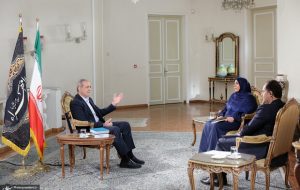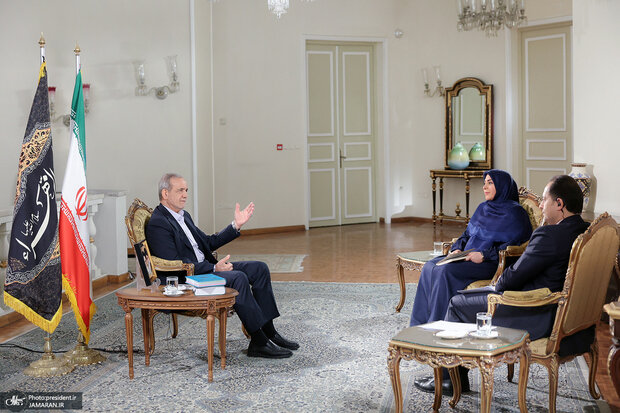Economic Analysis: Interview with Dr. Masoud Pezeshkian, President of Iran
TEHRAN – In a pivotal television interview marking the first 100 days of his presidency, Iranian President Masoud Pezeshkian delved into the challenges and opportunities defining his administration’s early tenure. Against the backdrop of a tumultuous political landscape and mounting economic pressures, President Pezeshkian outlined his government’s approach to tackling structural inefficiencies, inflation, and resource


TEHRAN – In a pivotal television interview marking the first 100 days of his presidency, Iranian President Masoud Pezeshkian delved into the challenges and opportunities defining his administration’s early tenure. Against the backdrop of a tumultuous political landscape and mounting economic pressures, President Pezeshkian outlined his government’s approach to tackling structural inefficiencies, inflation, and resource imbalances while fostering international economic partnerships.
The interview shed light on his administration’s multi-faceted strategy to revitalize the economy, including plans to address energy subsidies, stabilize inflation, and prioritize housing affordability. With a focus on long-term reforms, President Pezeshkian emphasized the importance of transparency, collaboration, and pragmatic policymaking in achieving sustainable growth.
This article explores the key takeaways from the President’s remarks, highlighting his administration’s economic agenda and the broader implications for Iran’s path forward.
Economic Challenges and Budget Planning
In his interview, President Pezeshkian highlighted several critical economic challenges faced by the 14th government, emphasizing a commitment to transparency in addressing the country’s financial crises. He noted that the national budget was prepared amidst limited time, prioritizing a clear presentation of all figures. Some critics viewed the budget as expansionary, but Pezeshkian clarified that it was designed to transparently reflect fiscal realities rather than introduce inflationary policies.
Energy Sector Disparities
The President addressed severe imbalances in energy production and consumption, calling the situation a “crisis-in-the-making.” The mismatch between power generation and national needs, compounded by excessive per capita consumption—significantly higher than in countries like the UK, Canada, and Germany—has led to resource depletion. For instance, oil and gas reserves in power plants, which previously exceeded 3.0 billion cubic meters, have dropped to just over 1.0 billion cubic meters this year. Without intervention, shortages are anticipated, with potential disruptions to winter gas supplies.
Pezeshkian stressed the need for sustainable solutions rather than temporary fixes, criticizing prior administrations for failing to address these disparities. Measures such as gas injections into oil wells, essential for long-term resource extraction, have been overlooked, jeopardizing the future energy landscape.
Economic Roadmap and Strategic Initiatives
To tackle these challenges, the government convened an economic task force, including the Minister of Economy, Central Bank officials, and academic experts. This team has identified five key areas of focus:
Investment and Production Growth: Encouraging domestic and foreign investment to boost production capacity.
Addressing Structural Imbalances: Developing strategies to stabilize the economy.
Household Welfare and Food Security: Ensuring access to essential goods and services.
Resolving Budgetary Disparities: Prioritizing efficient allocation of resources.
Industry and Economic Growth Drivers: Targeting sectors with high potential for economic growth.
According to the President, these pillars have been broken into 25 sub-programs to ensure actionable outcomes.
Inflation and Public Welfare
Pezeshkian acknowledged the persistent issue of inflation, which has averaged 40 percent over the past five years. Despite recent improvements, with point-to-point inflation dropping to 32.5 percent this autumn, he admitted that economic pressures continue to burden households. The government plans to manage inflation by preventing fuel price hikes and reallocating resources. However, he emphasized the importance of making tough decisions, including potential adjustments to subsidies, to stabilize the economy.
International Economic Cooperation
On foreign policy, Pezeshkian underlined efforts to enhance regional and global economic relations. Iran has engaged in over 100 high-level meetings with international leaders, fostering trade agreements and partnerships. Upcoming collaborations with the Eurasian Economic Union and bilateral agreements with China, Russia, and India aim to reduce tariffs and expand market access for Iranian producers.
These agreements, particularly in energy and transportation, are seen as pivotal for revitalizing Iran’s economy. Pezeshkian emphasized the importance of aligning domestic industries with international opportunities, ensuring that tangible benefits reach the public.
Conclusion
The interview painted a comprehensive picture of Iran’s economic hurdles and the government’s multifaceted approach to overcoming them. By addressing energy imbalances, inflation, and international trade barriers, the administration hopes to set the stage for sustainable growth. However, Pezeshkian was candid about the challenges ahead, calling for unity, expert guidance, and public support to navigate this critical period.
EF/
